It's inevitable, wherever people go there is trash left behind. And so it is in deepest space, with cast-off equipment from old satellites and pieces of rocket. Now a Japanese company is introducing a vessel, named "Kounotori" (stork in Japanese), blasted off from the southern island of Tanegashima just before 10:27 pm local time (1327 GMT) attached to an H-IIB rocket and "the satellite was removed from the rocket" and put into the planned orbit about 15 minutes after the liftoff, JAXA spokesman Nobuyoshi Fujimoto on Tanegashima told AFP. The cargo ship is bound for the International Space Station, carrying a 'space junk' collector that was made with the help of a fishnet company, Nitto Seimo, to develop the cord, which has been about 10 years in the making.
"The tether uses our fishnet plaiting technology, but it was really tough to intertwine the very thin materials," company engineer Katsuya Suzuki told AFP. "The length of the tether this time is 700 meters (2,300 feet), but eventually it's going to need to be 5,000 to 10,000 meters-long to slow down the targeted space junk," he added. Previous experiments using a tether have been done in recent years.
Another spokesman for the space agency has said it hopes to put the junk collection system into more regular use by the middle of the next decade.
"If we are successful in this trial, the next step will be another test attaching one tip of the tether to a targeted object," he added.
The collection company and scientists at the Japan Aerospace Exploration Agency (JAXA) are experimenting with a so-called electrodynamic tether made from thin wires of stainless steel and aluminum to pull junk out of orbit around Earth. If this method proves successful it will enable the vessel to clearing up tonnes of space clutter including cast-off equipment from old satellites and pieces of rocket. There are estimated to be more than 100 million pieces in orbit, posing a growing threat to future space exploration, scientists say. The plan is for one end of the strip to be attached to debris that can damage working equipment—there are hundreds of collisions every year.

Japan's unmanned cargo spacecraft, "Kounotori" is to blast off from the southern island of Tanegashima around 10:30 pm local time attached to an H-IIB rocket
The electricity generated by the tether as it swings through the Earth's magnetic field is expected to have a slowing effect on the space junk, which scientists say should pull it into a lower and lower orbit. Eventually the waste will enter the Earth's atmosphere, burning up harmlessly long before it has a chance to crash to the planet's surface.
This is an issue that has been in-the-making for more than 50 years of human space exploration since the Soviet-launched Sputnik their first satellite in 1957. Since then the debris has begun to form a hazardous belt of orbiting debris.
"If we are successful in this trial, the next step will be another test attaching one tip of the tether to a targeted object," he added.

